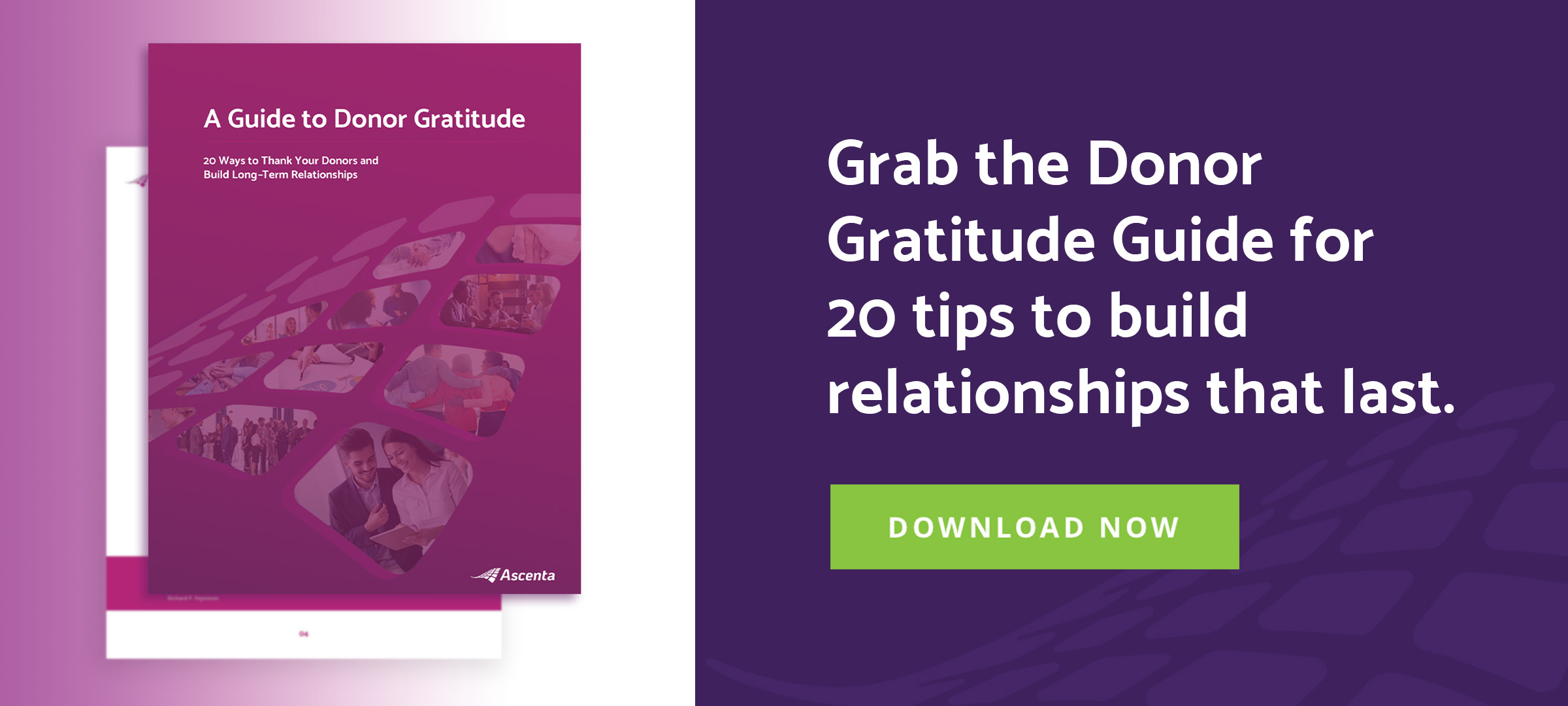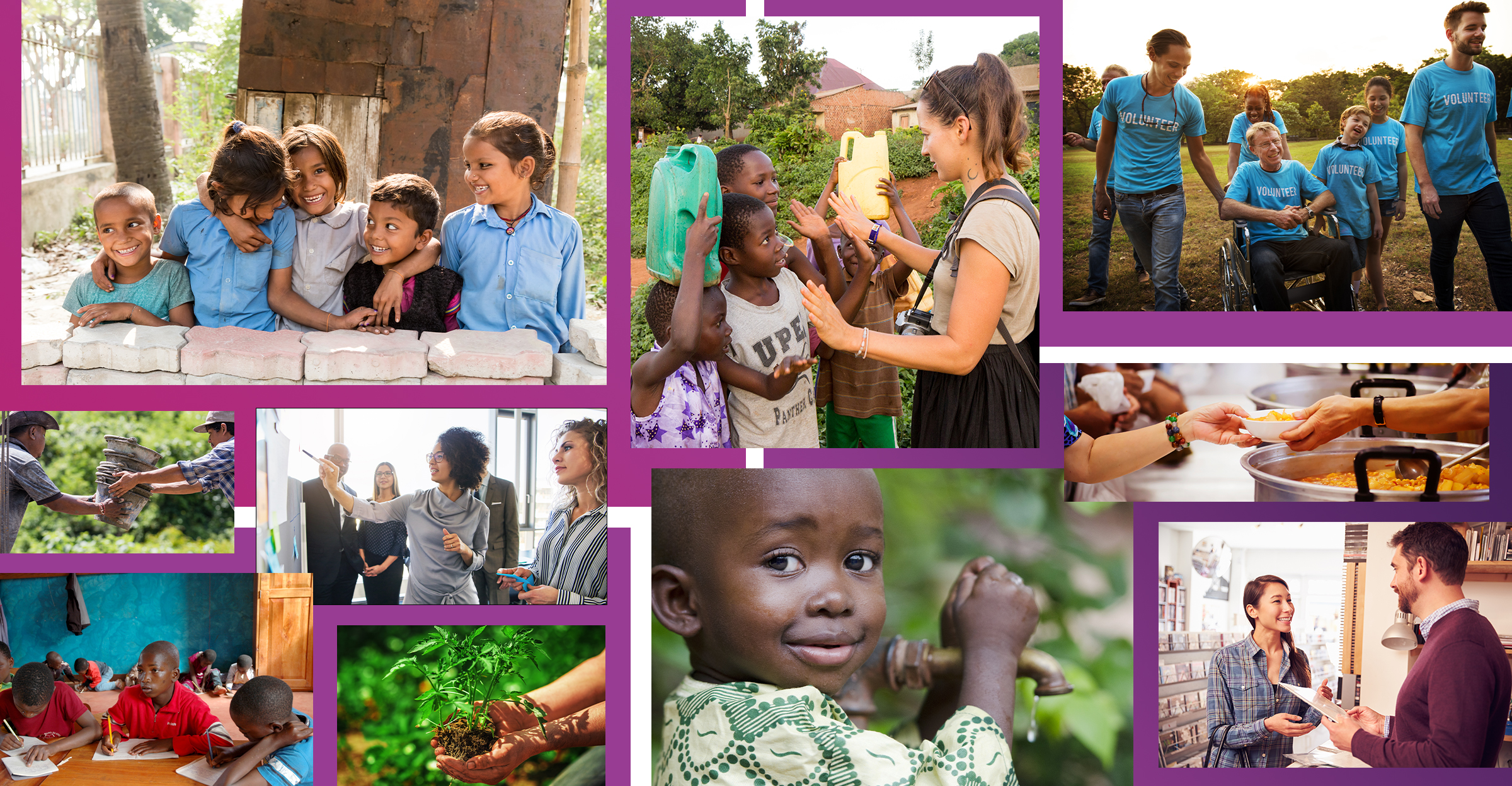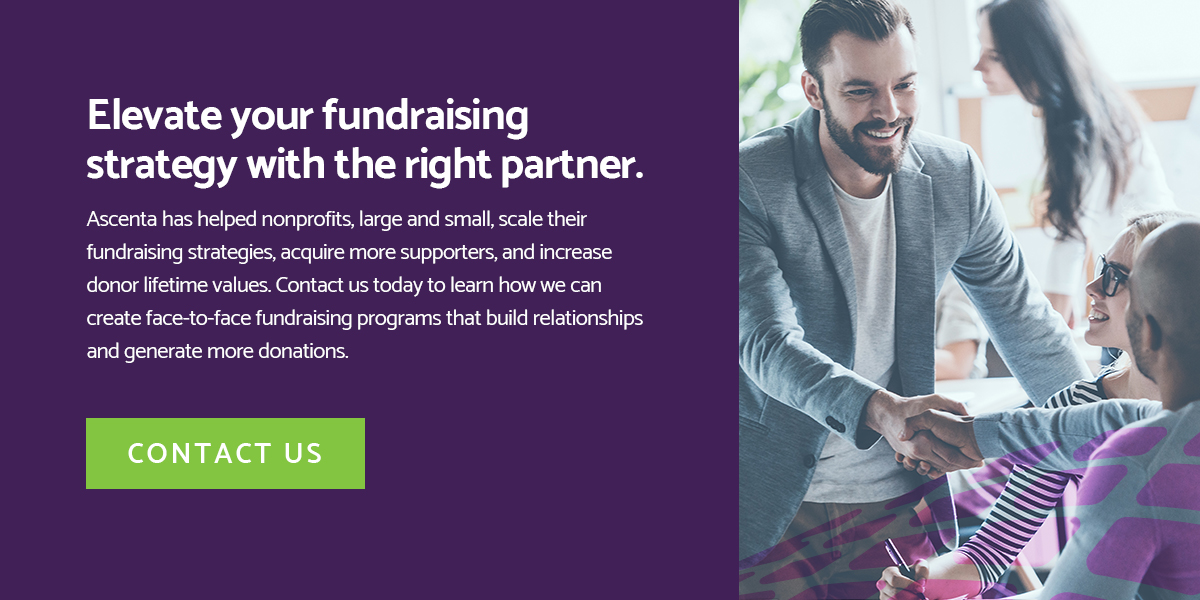Everything Non-Profit Organizations Need to Know About Non-Profit Fundraising Strategy
Table of Contents
Jump to your desired section

Fundraising is essential for non-profit organizations (NPOs), and creating a non-profit fundraising strategy is the first step to ensuring that you reach your fundraising goals. A successful non-profit fundraising strategy relies on your ability to get in front of the right people at the right time and place and tell your story in a way that drives action.
It’s important to focus on the big picture when creating fundraising strategy for your charity. Look beyond simply asking for donations and focus on ways to create lasting connections with partners and donors. This requires work before and after the contribution ask, such as introducing your story, communicating success stories, and evaluating automated marketing tools that can be used to increase conversion and retention rates.
Step 1: Creating a Compelling Story

Your non-profit fundraising strategy begins with your story. In fact, a well-developed NPO story becomes the basis for all your fundraising plans. Simply moving forward with the goal of “helping people” isn’t enough to be successful in your charity fundraising efforts. A compelling story clearly communicates your charity’s vision and purpose, who or what you help, and what makes you different from other non-profits. More importantly, it motivates donors to support your cause.
Your NPO’s story is used to guide all sales and marketing activities that support your fundraising strategy. In addition to serving as the basis for powerful headlines, taglines and values that become synonymous with your organization, it also directs your overall brand voice.
Your story comes to life in:
- Your mission statement and values that clearly explain your organization’s reason for being in just a couple sentences.
- Your website, including the “About” section, giving greater detail on your organization’s purpose and progress.
- Your elevator pitch is the “script” used to present your cause to potential donors.
- Your social media strategy as a part of your ongoing communications with public audiences.
A successful NPO story hinges on its ability to create empathy for your cause in order to drive action.
Provide an Overview
A compelling story captures the heart of your cause. The best non-profit stories provide an overview of your organization and:
- Expresses your charity’s “why” and purpose
- Shares key moments that spurred the creation of your NPO
- Identifies who or what you help, whether it’s a group of people, animals or set of ideals
- Explains your goals (i.e., an end to hunger, preservation of a species) in an emotional way that invites connection and contribution
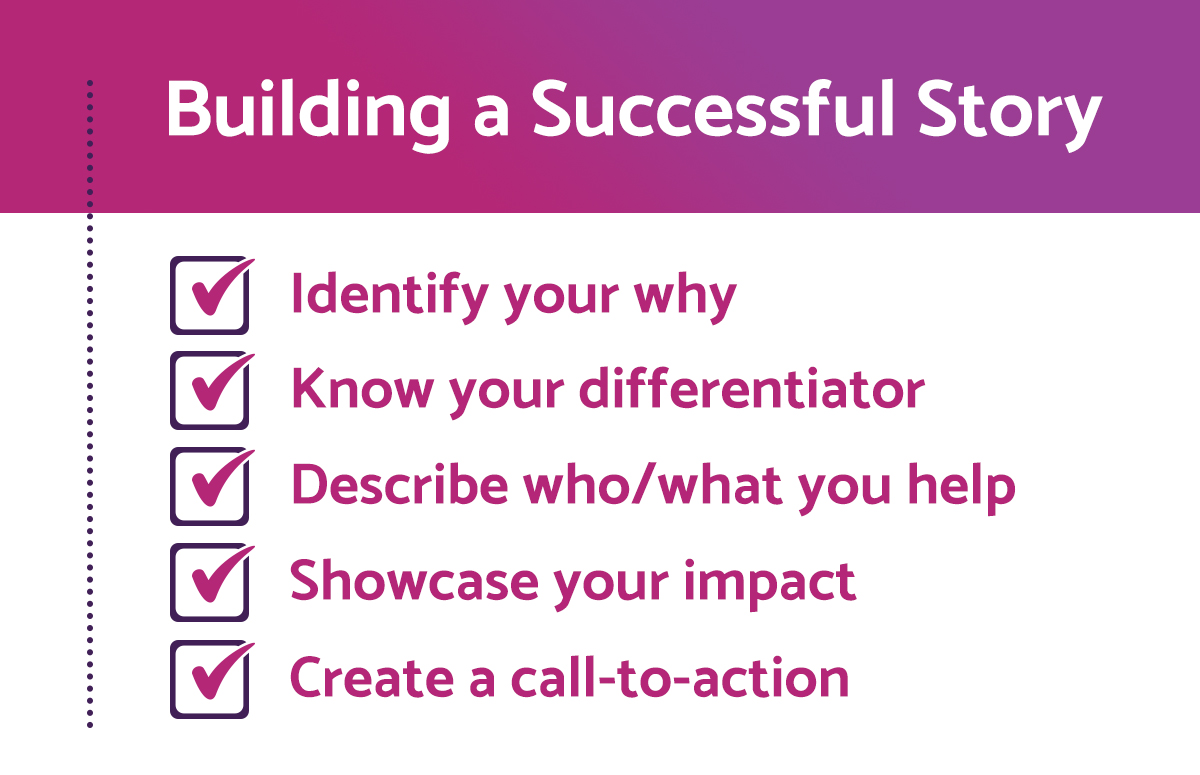
Explain Your Founding History
Start by sharing the motivation behind founding your charity. By focusing on the key pivotal moments that prompted your founders to create your non-profit, you can also spur action in supporters. Consider the following questions when developing your NPO story:
- Who is/are your founder/s?
- What personal perspective connects them to the cause your NPO supports?
- What pivotal moment/s prompted them to move into the non-profit sector?
Introduce Your Leadership
An organization can only be as passionate and successful as its leadership, and donors often want to know more about non-profit leaders and executives. Be sure to introduce the rest of your leadership team and:
- Share their connection to the cause
- Explain their background
- Identify their current role and level of involvement
Personify Your Beneficiaries
The next critical component of your brand story is explaining who or what benefits from your efforts. The direct beneficiaries of your charity may be people, animals, the environment, ideals or even things like historical building and constructs.

In each case, it’s important to clearly explain how your charity makes a difference. Sometimes your beneficiaries are highly specific, such as school-age children in the developing world who must sacrifice their education because they have to provide for their families.
Sometimes the beneficiaries of your charity are more indirect, such as the generations of people who will benefit indirectly thanks to the preservation of a particular animal species that is an important part of their environmental balance.
People have numerous causes vying for their attention. Cut through this chatter and stimulate empathy among donors by helping them understand exactly who their dollars will support.
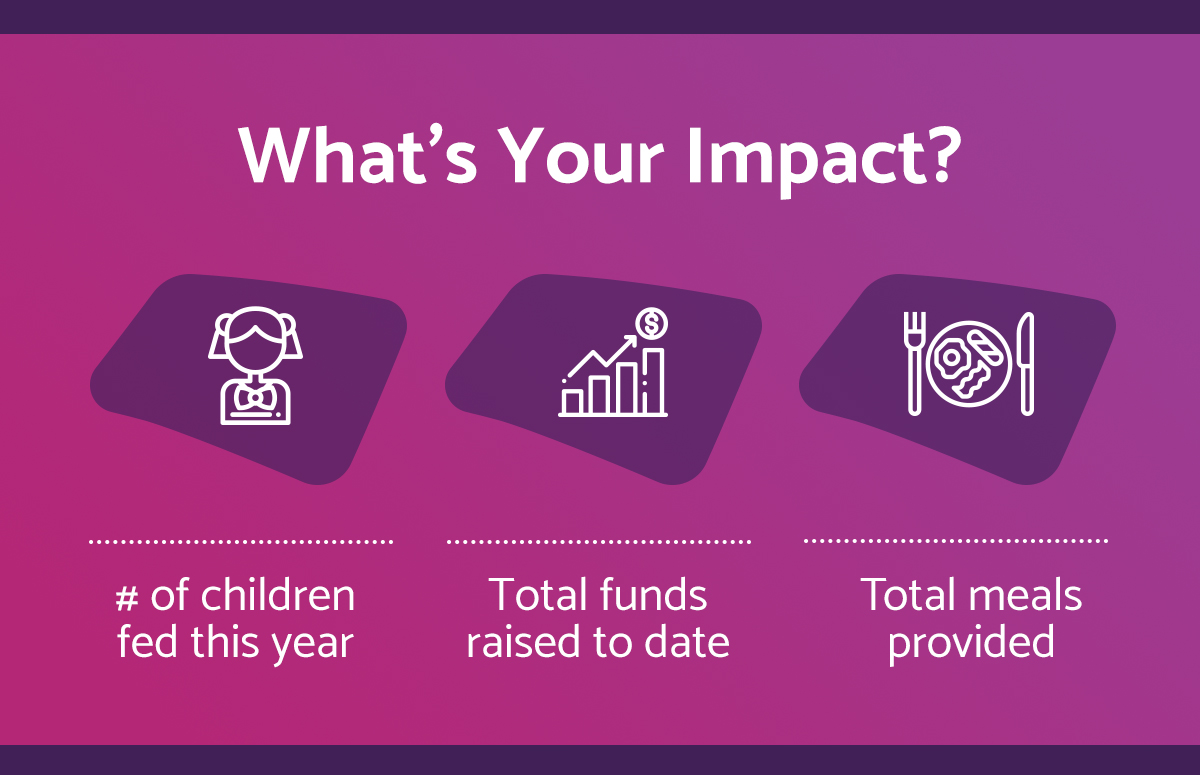
Illustrate Your Impact
It’s important to go a step further and share, not just who you help, but how. NPOs need to be prepared to share metrics that demonstrate success at fulfilling their mission and serving their beneficiaries.
Depending on your organization’s mission, the metrics you share in your story and ongoing communications could include:
- Total number of people or animals impacted, both directly and indirectly
- Total funds raised, year-to-date or lifetime
- Total items donated, installed, created, etc.
Sum It All Up in a Non-Profit Mission Statement
Ideally, your mission statement will be no more than a few sentences but will clearly tell donors:
- WHO you are
- WHAT you do
- WHY and HOW you do it
Your mission statement is often one of the most read pieces of copy that your organization will create. It must quickly explain what you believe in and create empathy for your cause. Develop a statement that is clear, concise, informative and stimulates action.
DonorBox, a software that supports donations and payments for non-profits, says that a strong mission statement will:
- Determine direction
- Motivate staff, supporters and volunteers
- Provide a template for decision-making
- Focus energy and attention
- Send a powerful message to the public
Take a look at these concise, well written mission statements from NPOs:
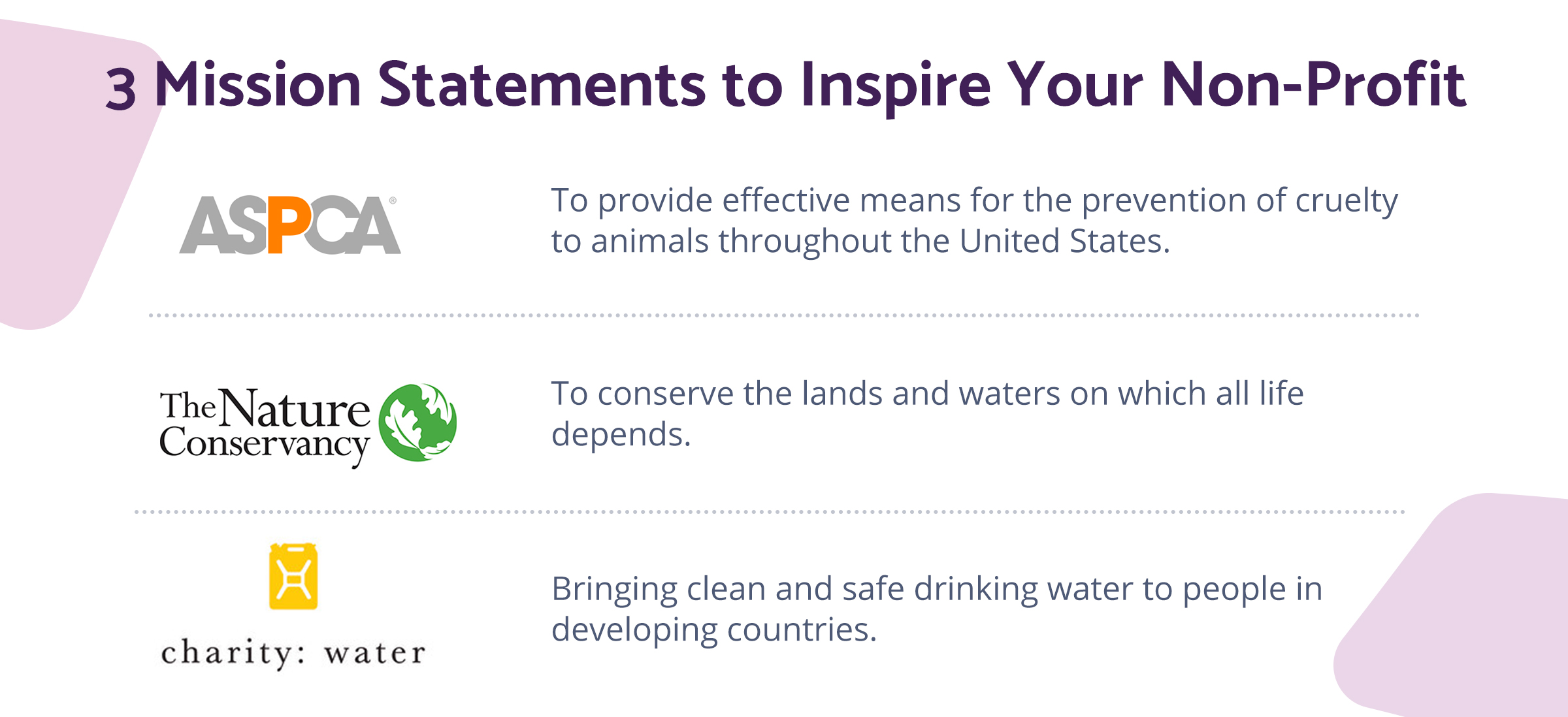
Draft Your Non-Profit’s Elevator Pitch
Now that you’ve documented your story, it’s time to create an elevator pitch for your non-profit that will often be referenced during your fundraising efforts. The ideal NPO elevator pitch:
- Explains your mission
- Encourages action
- Ultimately increases donations
Fundraising software provider Classy shares the essential components of a winning non-profit elevator pitch:
- The Hook
- The Body
- The Wrap-Up
- The Delivery
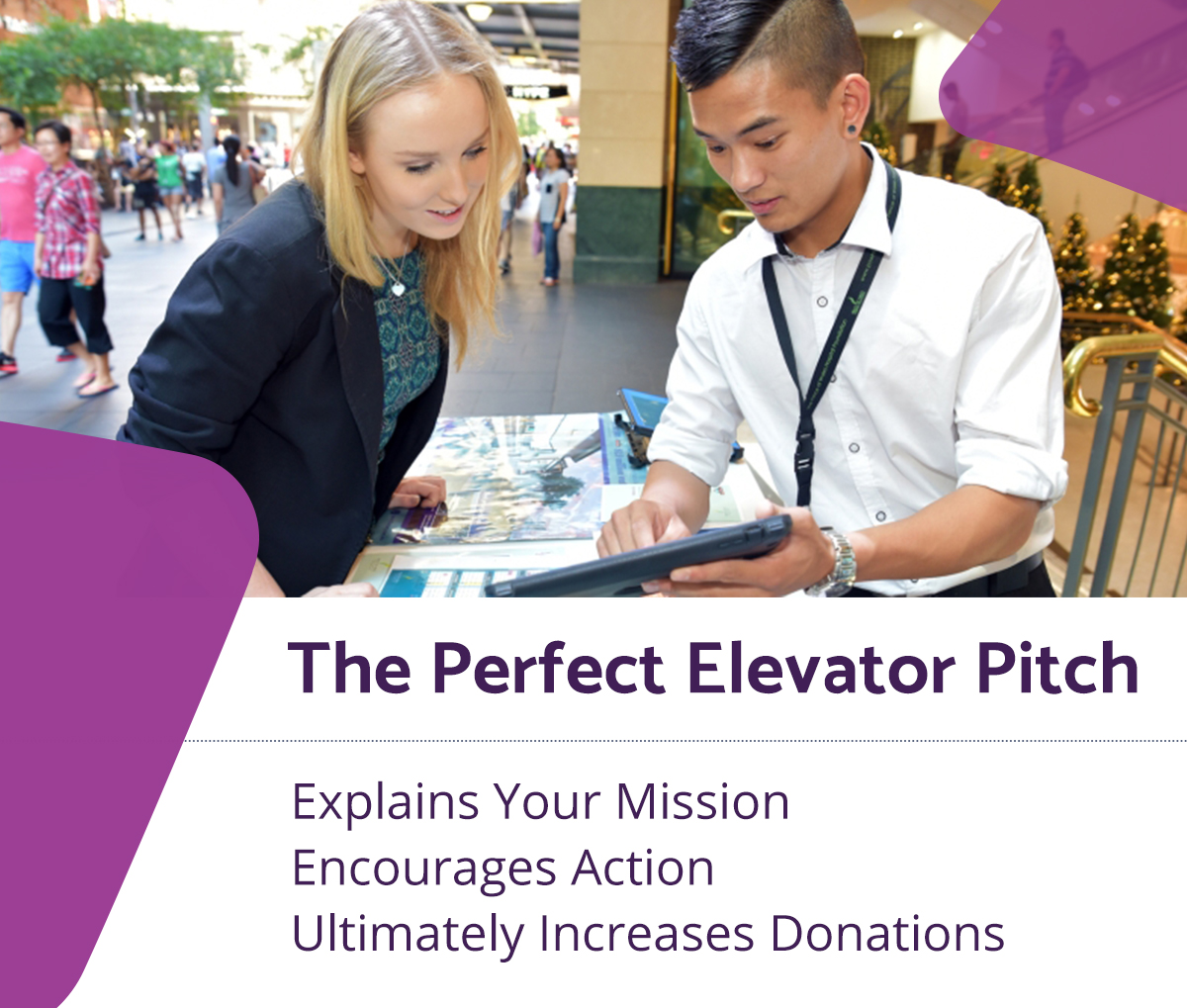
Your goal is to condense all that information from your story into a brief statement that communicates all the key elements, connects with listeners and drives a response. Successful NPO elevator pitches typically follow this outline:
- 15-second hook explaining who the charity serves, how it helps and what its desired outcome is
- 30-second body describing your specific impact
- 15-second wrap up with a specific ask for support
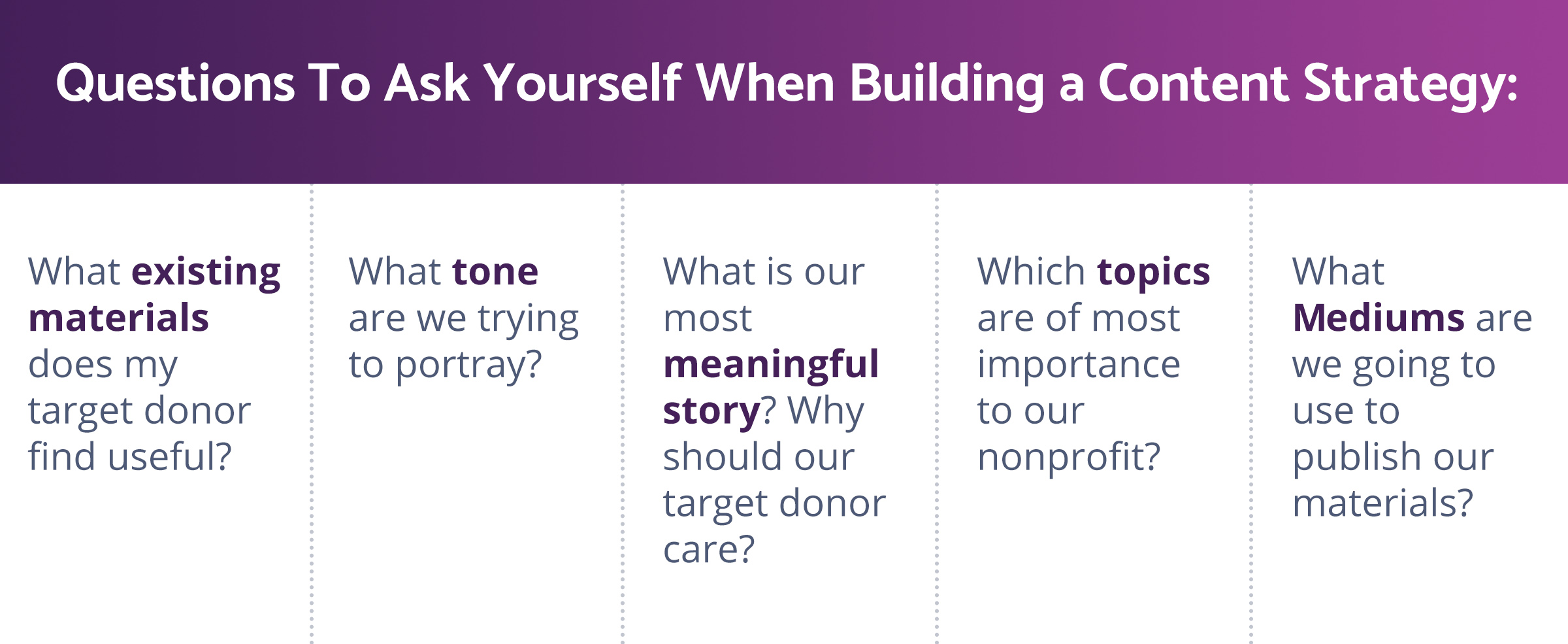
A content strategy is a comprehensive plan for all consumable brand touchpoints, online and offline: website, videos, social media, brochures, and all other sales and marketing collateral. Because content is where your mission and messaging comes alive, a clearly defined content strategy is important to driving your mission forward. When building out a content strategy for your nonprofit, ask yourself:
Build a Successful Content Strategy
- What existing materials does my target donor find useful?
- What tone are we trying to portray?
- What is our most meaningful story? Why should our target donor care?
- Which topics are of most importance to our nonprofit?
- What mediums are we going to use to publish our materials?
The most effective content strategies focus on getting the right content, to the right audience, at the right time. Here are a few steps to audit your current content ecosystem, create content that will reach your target donors, disseminate comms on the right channels, and measure content success:
- Audit existing content: Take an inventory of the assets that exist online and offline. What is currently working and what needs to be updated or retired? The insights gleaned in your audit should drive your future efforts forward. For instance, if you notice a website page gets little to no traffic, consider deleting it or giving it a refresh.
- Produce an editorial calendar: An editorial calendar will ensure that everyone on the team is centrally motivated and content efforts are planned and executed in a timely manner. When building out your fundraising strategy, construct a monthly or quarterly editorial calendar that will help to drive your key initiatives.
- Define your content KPIs: Determining your content KPIs will enable you to effectively measure the effectiveness of your content campaigns. Some examples of content KPIs may be, “increase social media click through rates by 10%, drive 3% more organic traffic to our website this quarter, and/or attract 5,000 website visits per month.”
- Disseminate content: You can craft the best piece of content, but if it doesn’t reach its intended audience, your efforts will have been in vain. During the content planning stages, map out where the piece will be published to ensure you’re keeping the audience of the medium in mind during its creation. Use website or publisher data to determine which medium will get your asset the reach you’re aiming for. For instance, if the majority of your target donors engage with your newsletter or blog, that will be a great medium to disseminate content.
Nonprofit Content Strategies to Mimic
There are many nonprofits that are strategically creating strong content marketing materials. If the content strategy you have in play isn’t generating the results you want, consider using the following examples as a launching point.
March of Dimes has become an expert in creating content that’s emotionally appealing to their audience. Their 2018 “We Won’t Stop” video campaign ads displayed the risks associated with pregnancy and labor. They also staged demonstrations at the National Mall that laid out blankets, one for every woman who dies in childbirth in the US per year, with the goal of driving earned media coverage. Ultimately, their online and offline content efforts worked together to advocate for getting the Preventing Maternal Deaths Act signed into law.
Big Brothers Big Sisters of America
Big Brothers Big Sisters of America utilizes a variety of content marketing channels including email, website, and social media to keep their audience informed and engaged with their mission. They also leverage video to disseminate their message and promote their cause.
Make-A-Wish has given children the opportunity to meet their favorite sports players, travel to Disney World, and even record professional music videos. These heartwarming stories make for impactful and inspiring pieces of content for Make-A-Wish’s audience. Make-A-Wish publishes their stories on YouTube, their website, Facebook, and Twitter.
Step 2: Getting to Know Your Donors

Now that you’ve developed a non-profit story that explains who you are, what you do, how you do it and the impact you make, you’re ready to get to know your non-profit donors.
Understanding the people who support your charity – both now and potentially in the future – helps you plan programs, giving campaigns and fundraising events that reach the right audiences and have lasting impact. While it’s not uncommon for charities to assume that they understand their audiences, when it comes to your fundraising strategy, documenting donor profiles often reveal surprising insights.
70 percent of Americans give to nonprofits and most philanthropic dollars are given by lower and middle-income households – not inaccessible wealthy people. ~ Entrepreneur.com
Collecting Donor Data
Data is key in understanding your donors. It’s important to collect as much information as possible about the people who give to your organization. Donor registration forms and donor surveys are great tools to help you collect standard demographic information like:
- Age
- Gender
- Marital status
- Income
- Location
- Education
- Occupation
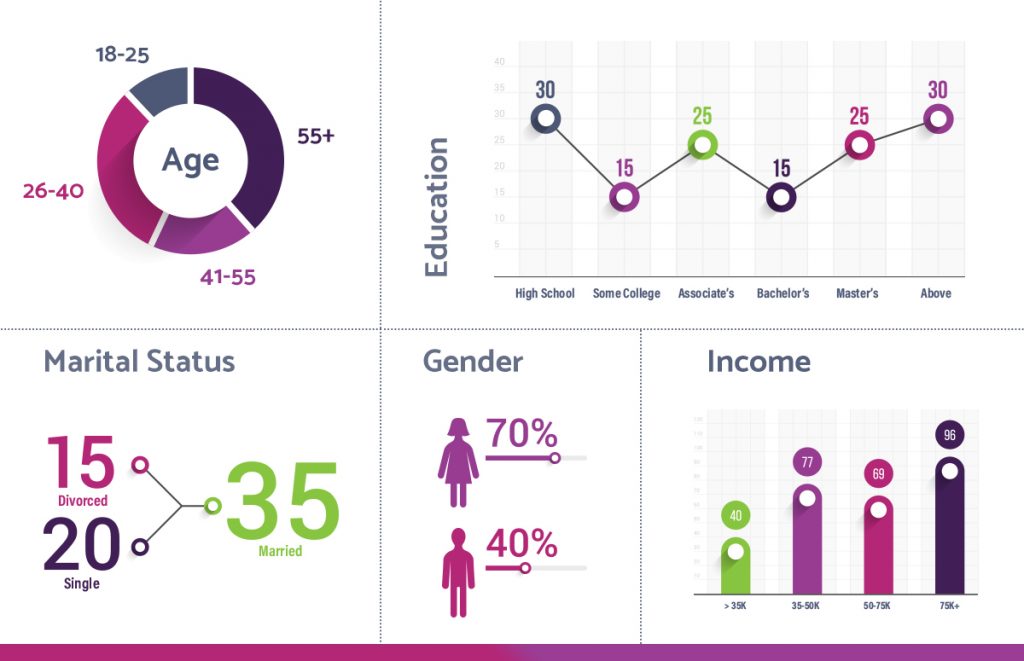
In addition to these fields, you can also use donor surveys to better understand why people give and why they choose your organization. Consider including questions like:
- What motivated you to donate to our cause?
- What other causes do you give to?
- What issues are important to you today?
- What types of donations do you typically make: monetary, supplies, time, financial, etc.?
- How do you prefer to make their donations: in-person, online, through the mail, over the phone?
- Do you follow us on social media? Have you ever visited our website?
Once you’ve gathered all this information about your current supporters, you can start to find commonalities in demographics and motivations. These clusters of similar supporters are the basis for creating donor profiles.
Best Practices to Track, Store, and Manage Donor Data
Every nonprofit needs the right tools, strategies, and processes to leverage their data and optimize their strategy effectively. The tools your nonprofit uses to collect and store your data is dependent on your organizations size, budget, and objectives.
It’s likely your nonprofit is already collecting and storing data in a CRM, spreadsheet, or another database tool. However, investing in tech providers that have designed solutions specifically for causes like yours will enable you to be as effective as possible.
You’ll also want to invest in tech that makes it easier to scale your efforts. Generally speaking, here are the tools most nonprofits need in their tech stack:
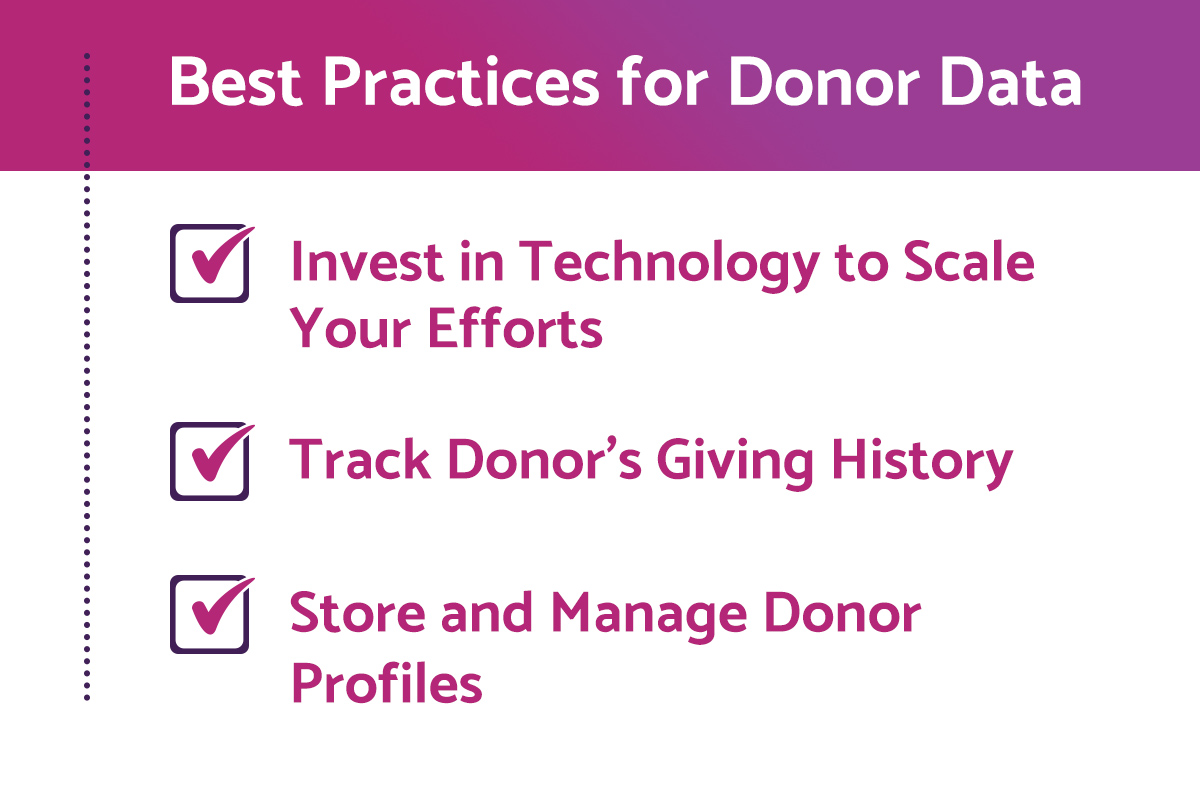
Donation Software: Donation software will give your donors the ability to easily donate from your website with a few clicks of a button. It also makes it simple to gather your donor’s information and collect donations in a cost effective manner.
Donorbox is a fundraising software that enables nonprofits to embed custom donation forms or popup widgets on their websites. More than 7,000 organizations in 25 countries use Donorbox to optimize their donation payment systems.
Customer Relationship Management: A customer relationship management tool will store and organize important donor information including contact information, engagement history, and donation history. Every donor and volunteer interaction can be tracked in a CRM, enabling you to manage and optimize the donor lifecycle.
You’ll likely want a CRM that is designed for nonprofit organizations like yours. Salesforce created Salesforce Nonprofit Success Pack, a CRM designed to aid nonprofits in cultivating solid donor relationships.
Email Automation: Email marketing is an excellent platform to build brand awareness, convert prospects, nurture relationships with existing donors, and improve donor retention. Email automation tools like MailChimp empower businesses to easily produce custom, branded emails and analyze reporting metrics.
Social Media Management: Social media is an excellent tool to disseminate your nonprofit communications and reach a wide audience quickly. However, manually posting directly from each platform can waste time and resources. Social media management tools like Hootsuite, help businesses schedule publishing more efficiently while engaging more effectively and with their followers.
Task Management: Task management tools will enable your team to manage their workload, stay organized, collaborate more efficiently, and ultimately, meet your organizational goals. A great tool for project management is Asana, a free platform with a user-friendly interface.
Track, Store, and Manage Donor Data
Track donors’ giving history: Whether your donors tend to give during the holidays, or for a specific campaign, the more information you collect about your supporters’ donation history, the better. The information gathered can be used to boost the performance of future fundraising and engagement efforts.
Store and manage donor profiles: A donor profile is a snapshot of the most important information about your donors. Storing and managing donor profiles effectively, will allow you to keep them up to date with the progress of your mission and solicit them for future donations. Here is the information you should be storing:
- Contact information: Name, address, email, phone number, and social media profiles.
- Donation history: Every time a person has donated to your cause, their donation amount, and the campaigns they donated to.
- Engagement history: Record the engagement touchpoints your nonprofit has with an individual–event invitations, or sending them an email.

Create Donor Personas
Rolling all of these insights and data up into donor personas will help your organization better understand your ideal donors, and their lifestyles, so that you can connect and communicate with them effectively. Understanding their motivations allows you to craft elevator pitches and marketing materials that speak directly to their needs.
Donor profiles should combine real data with strong anecdotal details to get a true picture of what types of people are most motivated to give to your non-profit.
Here are five steps that will help you create donor personas:
- Learn who you’re already working with. Look for data about your current supporters. This can be done by auditing your database, reviewing donor surveys, and leveraging digital analytics tools.
- Understand their connection to your cause. Donors who feel an emotional connection to the cause they’re supporting are more likely to donate frequently and in larger amounts. When creating donor surveys or sign-up forms, be sure to include questions about what motivates them to give to your charity.
- Identify their goals for giving. What do people hope to gain by giving to your charity? Once you know this, you know how you what wins and metrics are important to communicate with them.
- Share how your charity satisfies this need. Now that you understand why your donors are interested in providing their support, you can explain how your charity meets their giving goals. This may vary slightly for each type of supporter.
- Create specific personas using this information. Package all this information up into a simple picture of each donor group. Share these personas with your entire organization so that everyone has a deeper understanding of who supports your cause.
Donor Engagement Strategies
According to a report by Indiana University a 10 percent improvement in donor attrition rates can produce a 200 percent increase in each donor’s long-term projected value. It’s clear that repeat donors are extremely valuable to your nonprofits long-term growth and survival. A great launching point is to improve your overall donor engagement strategy with the goal of increasing repeat donor rates.
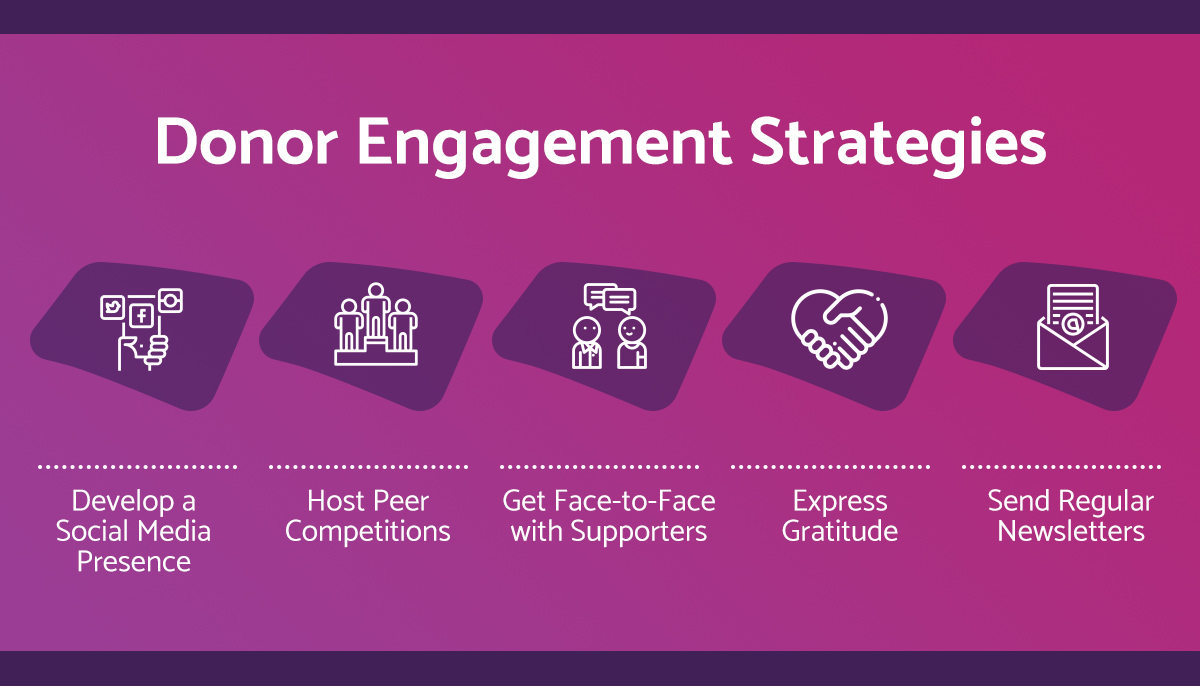
Here are outreach tactics that are the most effective to reach and engage with prospective donors:
Build a Social Media Presence: Social media has made connecting with people easier than it has ever been in history. Platforms like Facebook, Instagram, Twitter, and LinkedIn are great resources for nonprofits, as they present the opportunity to reach a large audience for a relatively low price point. Here are some tips to do social media right:
- Share with your followers frequently
- Implement a platform that allows you to schedule posts and engage with your followers
- Be sure to take photos at every event to share them with your followers
- Use relevant hashtags
- Regularly share your fundraising goal and the percentage of goal you have achieved
- Include a call to action button when it makes sense
Host Peer Competitions: Competitions amongst friends, families, and peers can be incredibly effective motivators to encourage new and existing donors. Peer competitions are a great donor engagement strategy that encourages new volunteers who might not have heard from your cause otherwise.
Get Face-to-Face with Supporters: Getting face-to-face with prospects and existing donors creates awareness for your cause, converts prospects into donors, and drives long-term, meaningful relationships with your supporters. In a world that has gone digital, face-to-face interactions aid in bringing your cause to life.
Express gratitude: Thanking your donors for their continued support makes donors feel more appreciated and encourages future giving. In fact, a study conducted by the Connecticut Council for Philanthropy found that 95% of donors would appreciate a ‘thank you’ call one to two days after they donate. Immediately after a donation is made, you can set up an automated email thanking them for their donation. From there, you can call donors or send physical ‘thank you’ notes in the mail.
Send Regular Newsletters: Newsletters can improve the communication methods between nonprofits and their supporters. When executed correctly, a newsletter will increase donor engagement levels while continuously sharing how the mission is being driven forward.
Step 3: Review Past Fundraising Efforts

Set a Baseline
When planning the fundraising strategy for your charity, it’s important to what has worked (and what hasn’t) for your NPO in the past. To do this, review both individual campaigns from the past several years as well as overall fundraising performance on a monthly and annual basis.
Some metrics to consider evaluating include:
- Total funds raised for each campaign
- Percent to fundraising goal
- Percent change in funds raised over past campaigns/years
- Total donors who contributed
- Number of new donors
- Number of lapsed donors reactivated
- Numbers of donors who moved to a higher giving level
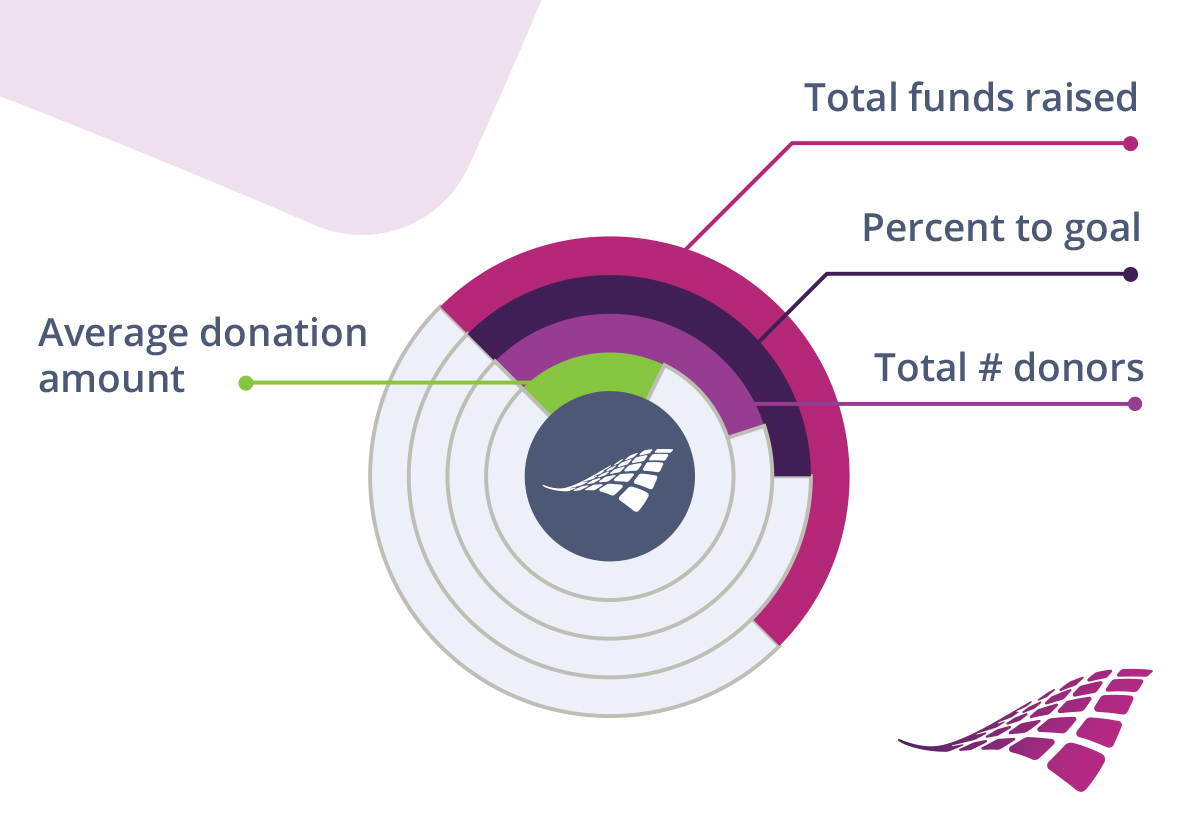
Once you document this data, assess overall trends to see if results improved or declined compared to the previous period. Monitor the percent change between campaigns, months or years for certain metrics and determine the average percent change. Use these trends as the baseline metric for future campaigns. For example, if you typically see a 15% increase in the number of donors during November, then account for that spike when planning your monthly goals.
Individual metrics, overall trends and baseline expectations provide much needed insight into the logistics of your past campaigns. You can go one step further by performing a SWOT analysis to measure your strengths, weaknesses, opportunities and threats.
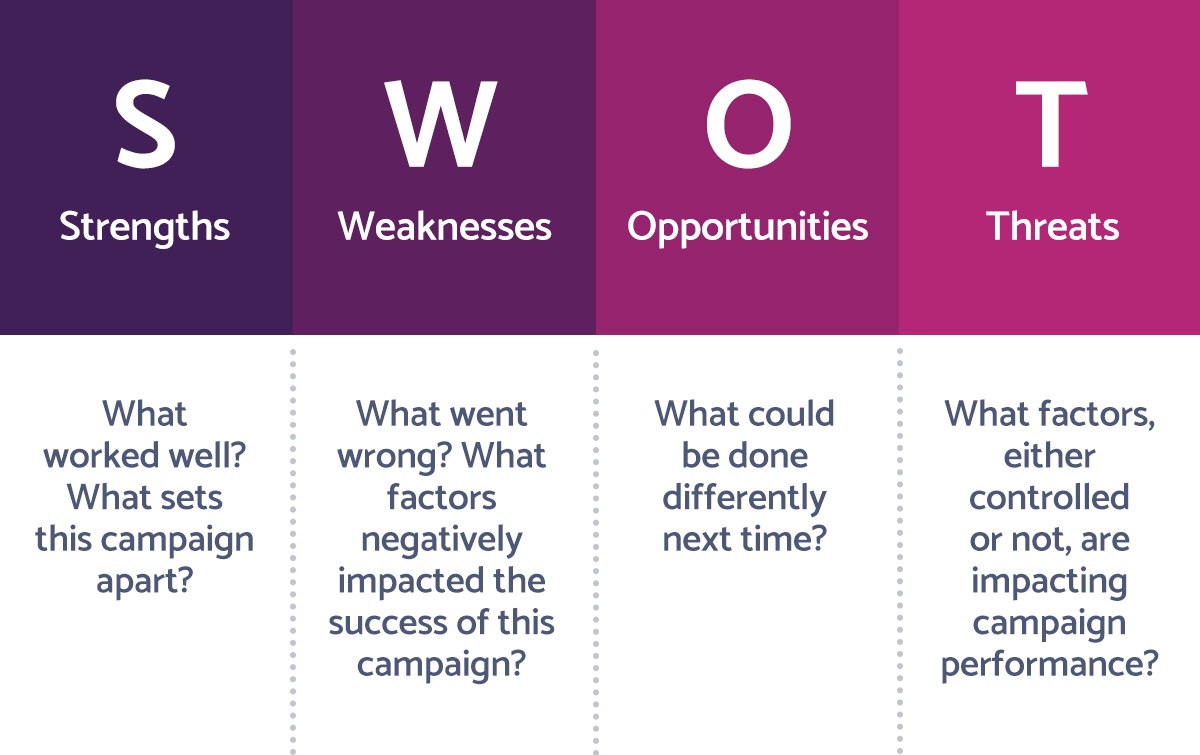
A SWOT analysis also gives you to the opportunity to provide more detail and explanation about non-quantifiable factors affecting your campaigns. It can be helpful to ask different departments to perform a SWOT analysis on the same campaign and compare those results to get a full picture.
The Evolution of Giving
The early days of nonprofits focused primarily on inspiring people to do good. And while doing good and driving the mission forward is top priority, nonprofits are also heavily focused on accomplishing benchmarks and generating revenue. In this new landscape, technology has given rise to many new methods that nonprofits can use to interact with their supporters and collect donations. As giving continues to evolve, many organizations are left wondering how to keep driving their fundraising forward. Here are five innovative fundraising strategies to include in your plan if you haven’t already:
- Participate in Giving Tuesday: Giving Tuesday is a giving movement, empowering people and organizations across the world to give back. Created in 2012, Giving Tuesday continues to inspire people to give and do good in their communities. To join the movement, check out their website for details.
- Make it easy to donate online: You can’t expect to simply add a PayPal link to your site and watch the donations flood in. Instead, your website should encourage people to donate. The process should be quick, easy, and seamless.
- Create monthly recurring donation options: Obtaining monthly recurring donors should be one of your fundraising strategy’s top goals. Much like your online donation feature, monthly recurring donations should be simple and seamless for donors to execute.
- Round-Up donations: Restaurants, grocery stores, and even some websites and apps can give users the ability to round up their change to the nearest dollar and donate the difference to a charity.
- Encourage supporters to host community charity nights: Many supporters and eager to host events in their local communities. Schools, churches, parks, and community centers are all great venues for supporter led events. Promote your event programs to your loyal supporters and volunteers by making it prominent on your website and in your email communications.
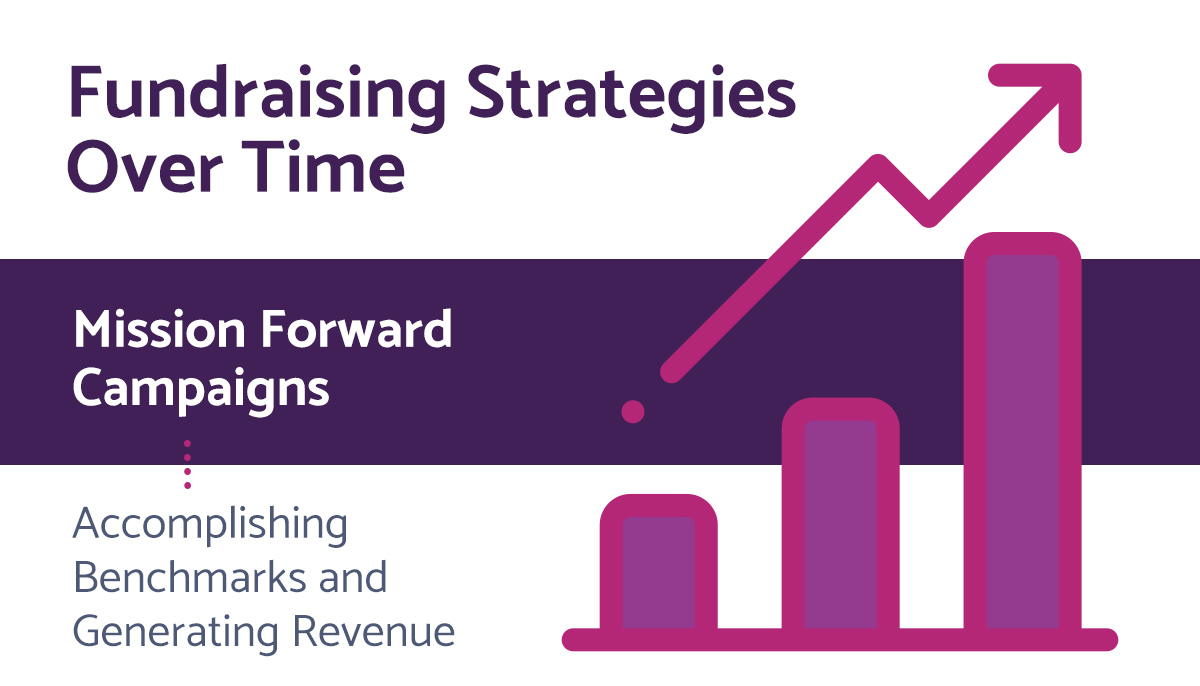
Step 4: Setting Fundraising Goals & Measuring Success

Every nonprofit organization, no matter its industry or size, should have defined goals. Without goals, a nonprofit wouldn’t be able to effectively engage supporters, serve the community, and ultimately, achieve its mission. Setting fundraising goals helps you motivate your teams and enables you to measure the success of your charity’s fundraising efforts. When establishing your fundraising goals, be sure to:
- Create clear, measurable outcomes.
- Have a comprehensive understanding of success benchmarks.
- Measure goals against the non-profit’s overall mission.
Get Smart About Fundraising Goals
To do this, many organizations use a “SMART” approach. This common acronym stands for Specific, Measurable, Attainable, Relevant and Timely. It’s a way to make sure that your goals are relevant and attainable.
- Specific – Specific goals are both clear and detailed. See if your goal can answer the five “W” questions: what, why, who, where, when.
- Measurable – Measurable goals make it easy to know when you’ve reached your target. State the specific units of measurement you’ll use, like the number of donors acquired or the number of people impacted.
- Attainable – While big goals can be a driving motivation to do great things, your goals should be realistic and achievable. Consider the time and resources required to reach each goal so you can set reasonable expectations.
- Relevant – It’s best when your goals are aligned with your charity’s overall mission and objectives. If your annual objective is to increase donor retention by x%, then perhaps you don’t need to spend too much time working to get 1000 new likes on Facebook.
- Timely – It’s important to make your goals time-sensitive. Will this goal be accomplished in the next month, quarter, or year? Setting finite time frames makes it easier to measure success.
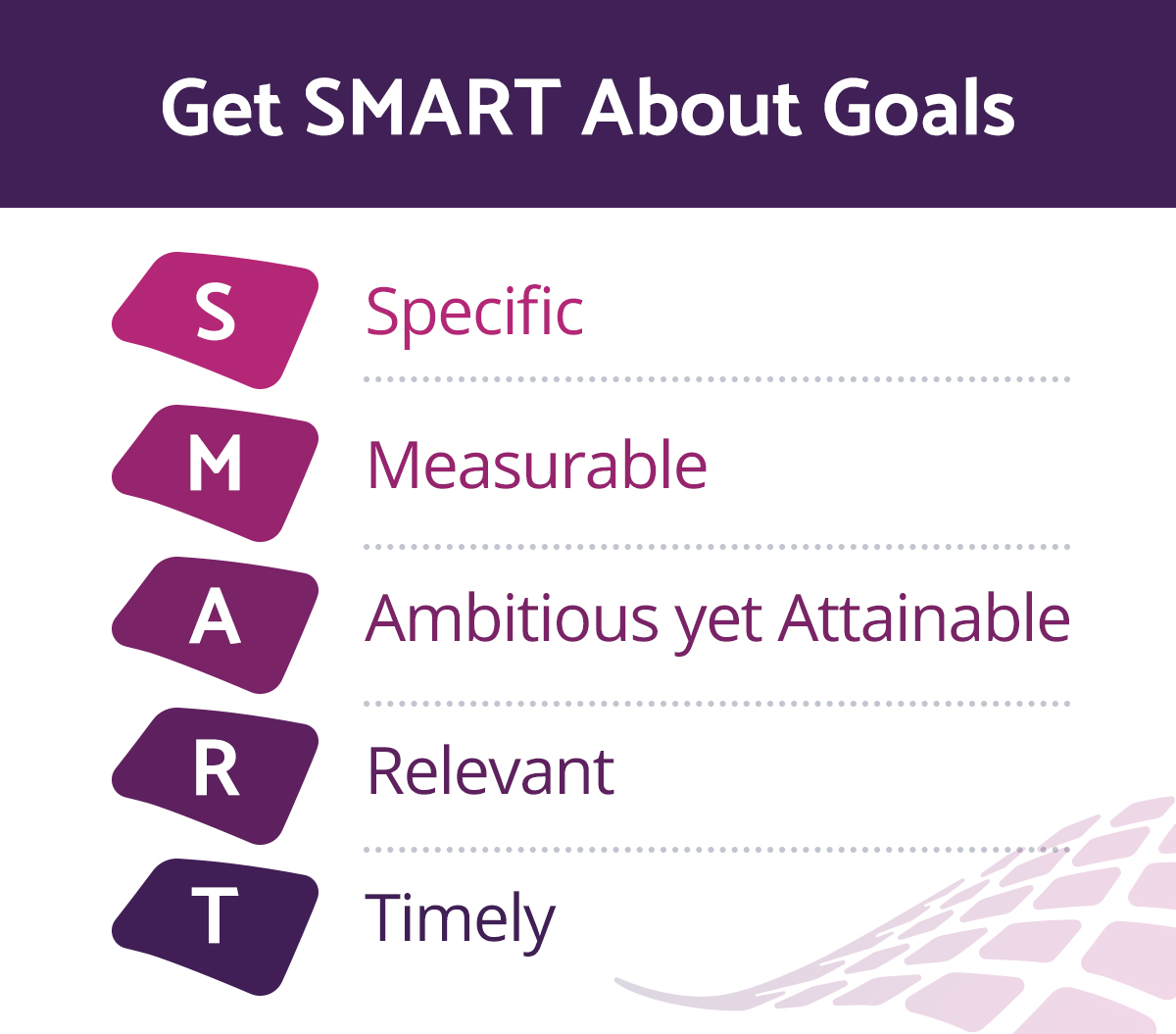
Define Your Short-Term and Long-Term Goals
Short-term goals are goals that your organization can accomplish in two quarters or less. These goals are usually completed in days, weeks, or months, and are often flexible to meet the changing needs of the organization. An example of a short-term goal might be to “add 100 new donors this month.” From there, you’ll be able to set smaller tasks to achieve your goal.
Conversely, long-term goals are goals in the relatively far future. Typically long-term goals are around growth, revenue generation, or driving missions forward. A clearly defined mission statement will define your nonprofit’s long-term purpose and enable teams to understand what needs to be accomplished can be determined. ]Like any goal, long-term goals should be specific, measureable, and achievable. For example, your mission is to end homelessness in a city, a long-term goal may be “Set up 20 homeless shelters over the next three years.”
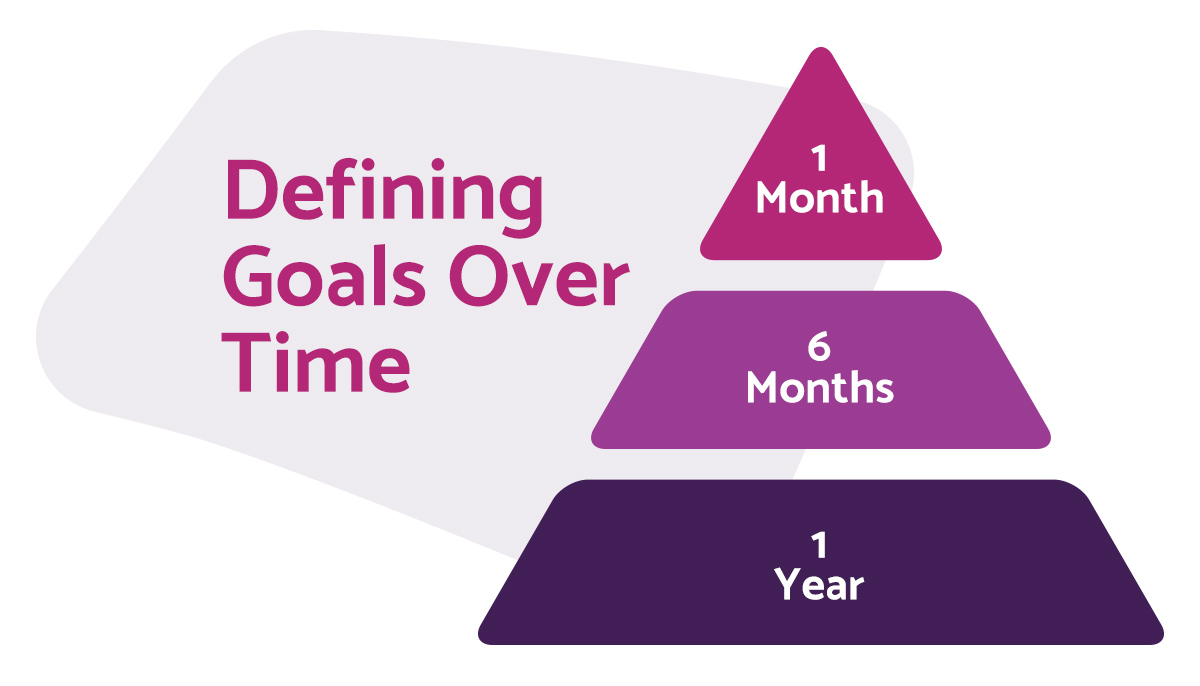
Both short-term and long-term goals should be central to your planning efforts. After all, setting deadlines to achieve your goals will help you succeed in the short and long term. And small, incremental goals will help you reach your larger, overarching goals. I am text block. Click edit button to change this text. Lorem ipsum dolor sit amet, consectetur adipiscing elit. Ut elit tellus, luctus nec ullamcorper mattis, pulvinar dapibus leo.
The Metrics that Matter Most for Non-Profits
There is no shortage of metrics to measure, and it’s easy to get lost in analysis paralysis. It becomes even more overwhelming when you’re using digital marketing tactics as part of your fundraising strategy. This opens you up to a whole new world of web traffic and conversion rates that can feel overwhelming.
Rest assured. You don’t have to measure everything. Using your goals as a guideline, get together with your team and decide what the eight or ten most important metrics are for your organization to measure.
Fundraising metrics often center around these common areas:
- Total funds raised
- # of donations
- average donation amount
- % to goal
- Total number of donors
- # of new donors
- # of repeat donors
- # of reactivated donors
- Fundraising channels
- % donations from face-to-face
- % donations through website
- % donations via tele-fundraising
- Donation types:
- % from one-time donations
- % from recurring donations
- % from corporate donations
- Donor retention:
- # new recurring donors
- # of recurring donors lost
- average # months recurring donors stay
- Conversion rates:
- % of donors who sign up after watching, hearing or reading your pitch
- Return on investment
- cost per dollar raised
- % change in cost per dollar raised
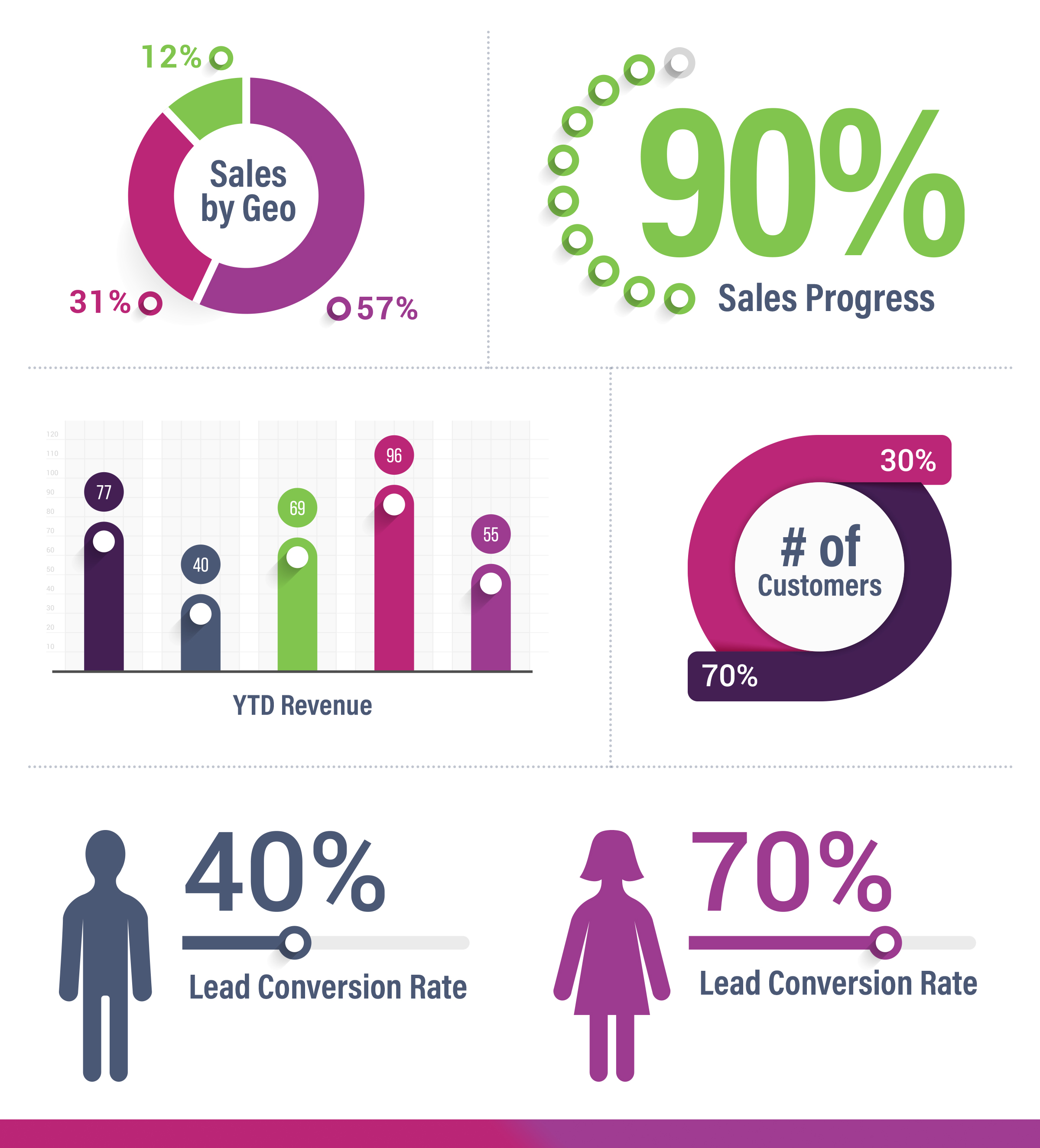
Implementing a Regular Reporting Process
Measuring performance against your goals is critical to success. Not only do you likely need to report final campaign financial data to your leadership team, but you also want to regularly review performance data. Monitoring progress allows you to identify what’s working and what’s not so you can adjust your fundraising strategy along the way.
There’s no right or wrong answer as to when you should review your campaign data. Some organizations monitor performance daily and use the learnings to constantly fine tune their efforts. Others evaluate progress weekly or monthly. Any of these approaches are fine. The important thing is to agree on a process and stick to it.
We encourage you though not to hold off until the end of the campaign, quarter or year. When you wait this long, you leave no time to act on the learnings.
Step 5: Establishing a Donation Structure

If you want to reach your fundraising goals, you need to make it easy for people to give. This means accepting multiple forms of payment, processing donations via your website and establishing multiple donation structures.
Entrepreneur points out that organizations tend to raise more funds when they focus on engaging different types of donors, including:
- Prospective donors – These are people who have not donated yet but are well matched based on your donor personas.
- Individual donors – Individuals typically provide the majority of donations NPOs receive. Individual donors may give once, multiple times or on a regularly recurring basis.
- Major donors – These are people who make larger contributions, often annually or several times a year.
- Corporate donors – It’s common for some businesses to make annual donations to non-profit organizations. In recent years, the market has seen a rise in corporate donors. While the benefits to the corporations typically included things like tax advantages or PR opportunities, philanthropic efforts are becoming a core part of companies’ cultures and recruiting initiatives.
- Foundations – Private foundations typically open a grant proposal round once or twice a year to award funding to NPOs who apply and meet their criteria.

Donations may come in the form of:
- One time donations – According to Bloomerang, nearly 70% of donors make one-time donations.
- Recurring donations – The bread and butter of many NPOs, recurring donations are typically received each month. Network for Good reports that recurring donors give nearly 50% more annually than one-time donors.
- Corporate donations – Corporate sponsorship spending for 2018 was expected to reach $24.2 billion in North America.
- Grants – Typically offered up by private foundations, these gifts are tied to a specific project or activity. Giving from foundations hit $58.46 billion according to a Giving USA
Tips for Creating a Donation Structure
Tips for Creating a Donation Structure
First, it’s important to understand which donors and donation types provide the most value to your charity. Once you’ve done this, be sure to:
- Offer options: Create enough donation tiers that donors have options. Review past donations and see which options are most preferred among donors. Consider removing tiers that aren’t as popular.
- Explain the difference: Provide explanations of each tier that are short, easy to read and clearly show the difference between options.
- Consider past performance: Review past donors and giving trends to determine which donation options are most successful in reaching your goals.
Focus on Building Trust and Proving Impact
People often want to know how their funds are being used. Therefore, building trust and credibility with donors is vital. A great strategy to build trust is to continuously communicate the positive impact campaigns have on your community. Additionally, you can increase your fundraising success and create tangible for donors by connecting your donation tiers with the actual impact each donation makes.
There are several ways you can do this:
- Human Impact
- Human impact describes how many people are impacted by a gift.
- “Your $100 donation feeds 45 families.”
- Materials Impact
- Materials impact describes how many units are provided thanks to a donation.
- “Your $100 donation provides 15 backpacks filled with school supplies.”
- Time-Based Impact
- Impact over time describes how long a gift will last.
- “Your $100 donation assures each patient receives a month of life-saving medication.”

Step 6: Increasing Donor Retention

In addition to generating donations, your NPO fundraising strategy should also consider ways to increase donor retention. It can be up to 10 times more expensive to attract a new donor than to preserve relationships with current donors.
Committed donors make it easier to project annual funds raises, are more likely to support multiple projects and can provide valuable insights to help guide future programs.
The average donor retention rate in the U.S. after the first gift is around 45 percent. There are several reasons why donors choose to continue giving:
- They believe in your cause.
- You’ve made the giving process easy.
- They feel like their contribution is helpful and effective.
- You’ve expressed your gratitude and they feel valued.
- Your organization stays in touch through regular communications.
- You help them see the impact their contributions make.
How to Make a Good First Impression with Donors
To convert one-time donors to recurring supporters and increase retention rates, it’s important to make donors feel like an important part of your cause. A donor’s first impression of your NPO may happen in person, through email, social media, or mail.
- Develop a brand voice that is friendly, familiar and relatable.
- Review all marketing materials and digital assets to make sure they are on-brand.
- Ensure any meeting or event spaces are inviting and professional. Be mindful of climate factors like temperature, lighting and smell.
- When meeting in-person, be aware of your appearance, posture and smile often. Be warm and engaging.
Send a Thank You Note
People want to be acknowledged. Be sure to promptly recognize donations with a follow-up thank you note. This can be done with handwritten notes or automated email campaigns. Some organizations thank new donors publicly, via email newsletter, social media or in print. Just make sure if you go this route, that your donors have opted in to receive public acknowledgment.
Give a Gift
NPOs often give a welcome gift to new recurring donors, or as a thank you to people and organizations giving larger gifts. Gifts can be as small as a discount code or offer from a partner, a coffee gift card, or an ornament at the holidays.
You can also consider larger gifts for major or corporate donors. However, be sure to review your gift policy to ensure it doesn’t appear as though you are incentivizing donations.
Build Relationships with Ongoing Communications
Ongoing communications are vital to increasing retention and supporting your NPO marketing plan. People are more likely to contribute to causes they feel connected to. Providing updates about current initiatives, giving goals and the people impacted by your cause can help strengthen your relationships with supporters.
Be sure to develop a communication plan that outlines the audience, outreach method and frequency. Focus on the activities that drive the most engagement. The ideal activity type and frequency can vary by audience.

Strategies to Boost Donor Retention
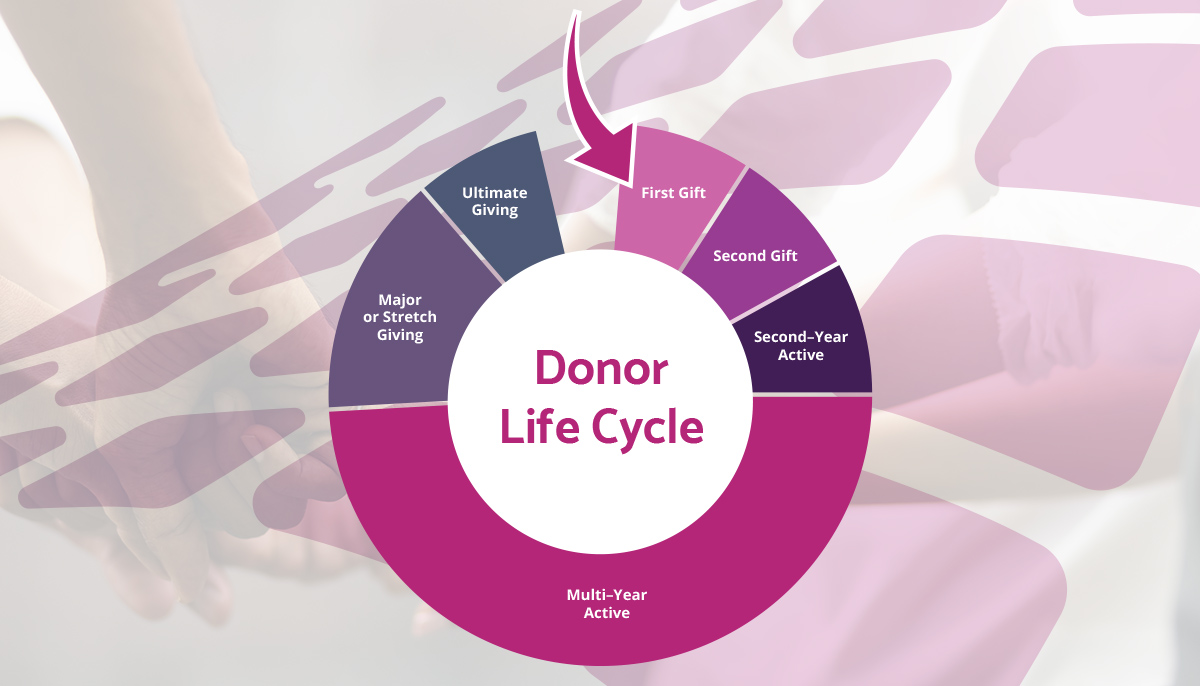
Relationship building shouldn’t end after a potential donor makes their first donation. Rather, solid relationship building tactics should be implemented throughout the donor lifecycle to strengthen relationships and improve donor retention. Here are a few strategies many organizations implement to boost donor retention:
Share Inspiring Stories
Avoid soliciting for donations each time you engage with a donor. If every newsletter, mailer, or email you send is a solicitation, they are likely to disengage, stop reading what you send, or even unsubscribe from your messaging altogether. Instead, focus on incorporating powerful stories about the impact you’re making on your mission. For instance, creating a video that demonstrates the impact you’re volunteers and donors are making in your community can be a powerful tool to influence repeat donations.
Send Handwritten Notes
Expressing gratitude throughout the donor lifecycle can improve donor retention rates. You’re likely already thanking your donors via an automated email each and every time they donate. However, sending a handwritten thank you note goes the extra mile and shows your supporters how much their donations mean to your cause.
Give Donors a Voice
Your organization’s mission is near and dear to your donors. That’s why they chose to gift to your organization in the first place. Establish methods for your donors to be heard and provide feedback. Use surveys to understand how they think you are performing, give feedback, and allow them to make suggestions.
Advertise Matching Gift Programs
Many of your supporters might not be aware that their employer offers matching gift programs. Be sure to communicate the matching gift programs on your website and on other communication platforms to encourage matching gift donations.
Step 7: Identifying the Most Effective Marketing Channels

Once you have a powerful story, a deep understand of who your donors are, and well-defined fundraising goals, you can develop the “marketing” component of your fundraising strategy. A thoughtful marketing strategy will leverage multiple channels to put you in front of the right people in the right place at the right time.
When evaluating which channels will be the most effective for your organization, consider two important factors:
- Audience: Where can you market or advertiser that will cross paths with the day-to-day lifestyle and browsing habits of your fundraisers? Do they attend public events or read print publications? If so, which ones? Which websites do they visit? What geographical areas do they live in?
- Budget: After identifying potential channels, consider the investment and resources each activity requires and the return it’s likely to generate.
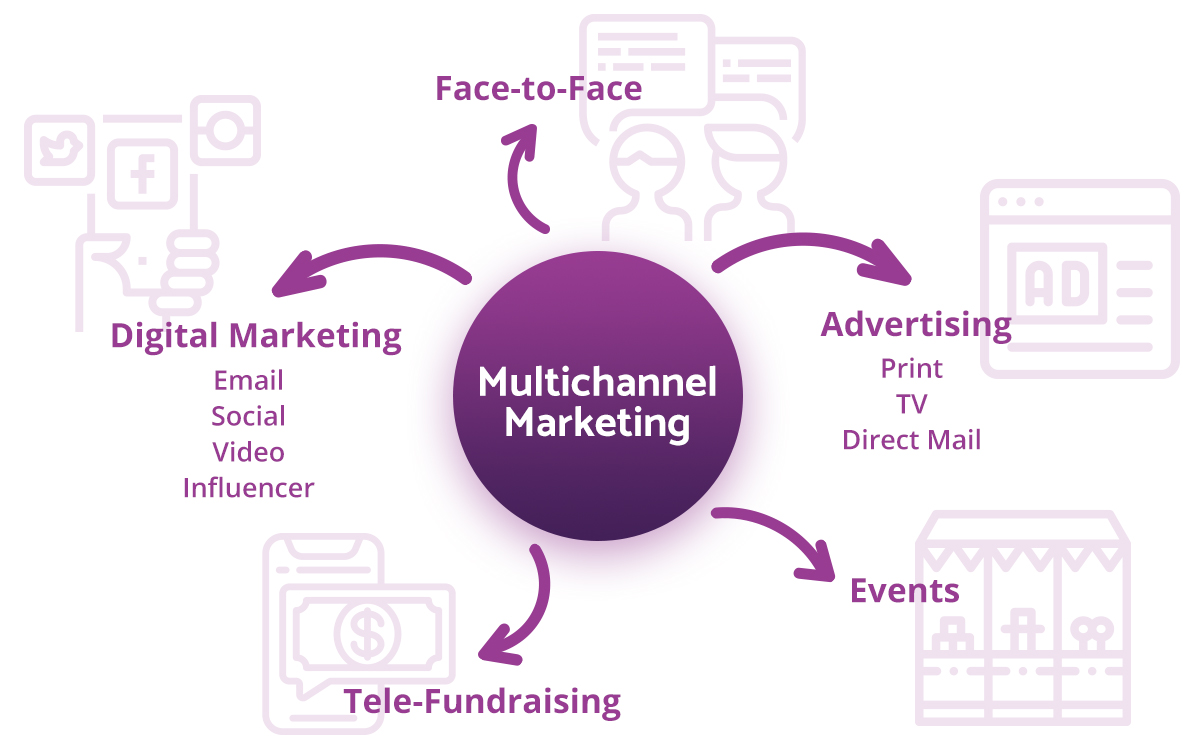
Advertising Channels for Non-Profit Organizations
Traditional advertising options have long been part of non-profit fundraising strategies. Options live television, radio and print are powerful channels to reach mass audiences. If it’s more targeted audiences you’re after, consider niche outlets and publications.
These channels tend to demand healthier budgets and often work best in conjunction with larger brand awareness initiatives.
Digital Marketing Tactics for Non-Profit Organizations
Digital marketing can be an effective way to maximize reach and minimize cost. Digital marketing for non-profit organizations includes:
- Email marketing
- Social media marketing
- Video marketing
- Influencer campaigns
- Pay-per-click advertising
- Display advertising
- Mobile marketing
It’s essential for NPOs today to have a well-rounded digital marketing strategy that delivers a consistent message and experience across all channels.
Tele-Fundraising and Face-to-Face Fundraising for Non-Profit Organizations
Although digital is important, you can’t neglect the important of human connection. After all, the heart of most non-profits are the people who run them.
Face-to-face and tele-fundraising bridge the gap that technology has created. These channels help put a face and a voice to your cause that a website simply can’t accomplish – which in turn lead to larger donations and increased donor retention.

PR Strategies for Nonprofits
The right PR strategies will help your organization build credibility, distribute your key messaging, and widen your reach. Here are best practices to build a successful nonprofit PR strategy:
Be Transparent: Organizations that establish transparent practices are more likely to be trusted than those that don’t. Transparency builds credibility and trust with your audience. After all, people donate to causes that they are passionate about; they want to know how their funding is being used. They’ll also want to know exactly how their donation is impacting the overarching mission.
Build an influencer network: Influencers are anyone with an engaged online following of supporters. Brands large and small have utilized influencers networks to advertise their products, solutions, and services. Partner with influencers who are passionate about your cause. These could be people in your existing network or even employees on your staff.
Work with an experienced team: Work with an experienced team that can identify paid and earned media opportunities and has a robust media list. They’ll have experience guiding nonprofit organizations to tell their stories to gain the most exposure as possible. Additionally, they will help you identify by-lined article and speaking opportunities.
Target the right media outlets: the media outlets you target are extremely important when building out your PR strategy. Conduct research to understand which publications you should focus your efforts on, and what reporters or editors you should contact.
Step 8: Creating Marketing Assets to Support Your Fundraising Efforts

Once you’ve identified the channels and tactics you’ll be using as part of your fundraising strategy, you can make a list of all the marketing materials and assets that will help attract new donors.
Marketing assets are the content, images, advertisements, etc. that bring your organization’s impact to life and help encourage people to give to your organization. Many of these materials will be evergreen, meaning that they can be used over and over again at a variety of events and interactions. Others may be campaign specific and or related to new initiatives you’re activating.
Digital Marketing Assets
- Website (This is by far the most important asset in your fundraising strategy.)
- Social Media Images
- Videos
- Email templates and graphics
- Banner ads
Evergreen Printed Marketing Materials
- Business cards
- Postcards
- Flyers and brochures
- Branded stationary & stickers
Campaign-Specific Printed Marketing Materials
- Direct mail
- Event collateral
- Branded gifts

5 Tips for Better NPO Marketing Materials
Regardless of whether you’re focused on online, offline or in-person channels, an effective fundraising strategy leverages a lot of content, images and other materials. There are a few things to keep in mind when creating this information.
- Develop strong brand guidelines that give direction on things like tone and personality, plus visual elements like colors, typeface and photography styles.
- Make sure all materials that represent your NPO adhere to these brand guidelines.
- Present your story clearly. Less is more. This holds true for brochures and social posts alike.
- Include your logo on all materials, and contact information where applicable.
- End with a strong call-to-action that encourages people to take a specific step like visit a website or click to make a donation.
Illustrating Impact Makes for Great Marketing
The most successful way to maximize donations through charity fundraising efforts is to create a personal connection with potential and current supporters. Sharing real stories of people you’ve helped is a great way to do this.
These narratives can be brought to life on postcards, through videos or featured as callouts in marketing materials like brochures and on your website. Putting real faces to your cause helps people feel an emotional connection that leads to donations.
Don’t Underestimate the Power of a Photo
There’s nothing like photos of the human experience to bring a cause to live. Invest in professional brand photography to develop a library of pictures that display the impact of your cause including shots of:
- Your fundraising teams at work
- Your field teams completing projects
- Individuals and groups impacted by your work
Step 9: Benefits of In-Person Fundraising

Although social media and screens are more prevalent than personal interactions, face-to-face connections present a critical opportunity for charities to build relationships that will last. In-person fundraising can be done:
- Door-to-door
- At pop-up events and through street teams
- At conferences and events
In-person fundraising is more effective than other forms of fundraising. NPOs from the largest organizations to small grassroots programs trust in-person fundraising to:
- Build a personal connection that deepens a donor’s connection to your cause and helps increase retention rates.
- Create experiences that allow people to envision their overall impact on a cause. Fun and interactive events can be a great way to capture the attention of prospective supporters, and keep recurring donors coming back for more.
- Increase retention and loyalty by differentiating you from other causes that are only shared online or via mail
- Keep costs low because this highly effective method can drive significant conversion rates, making for a higher ROI
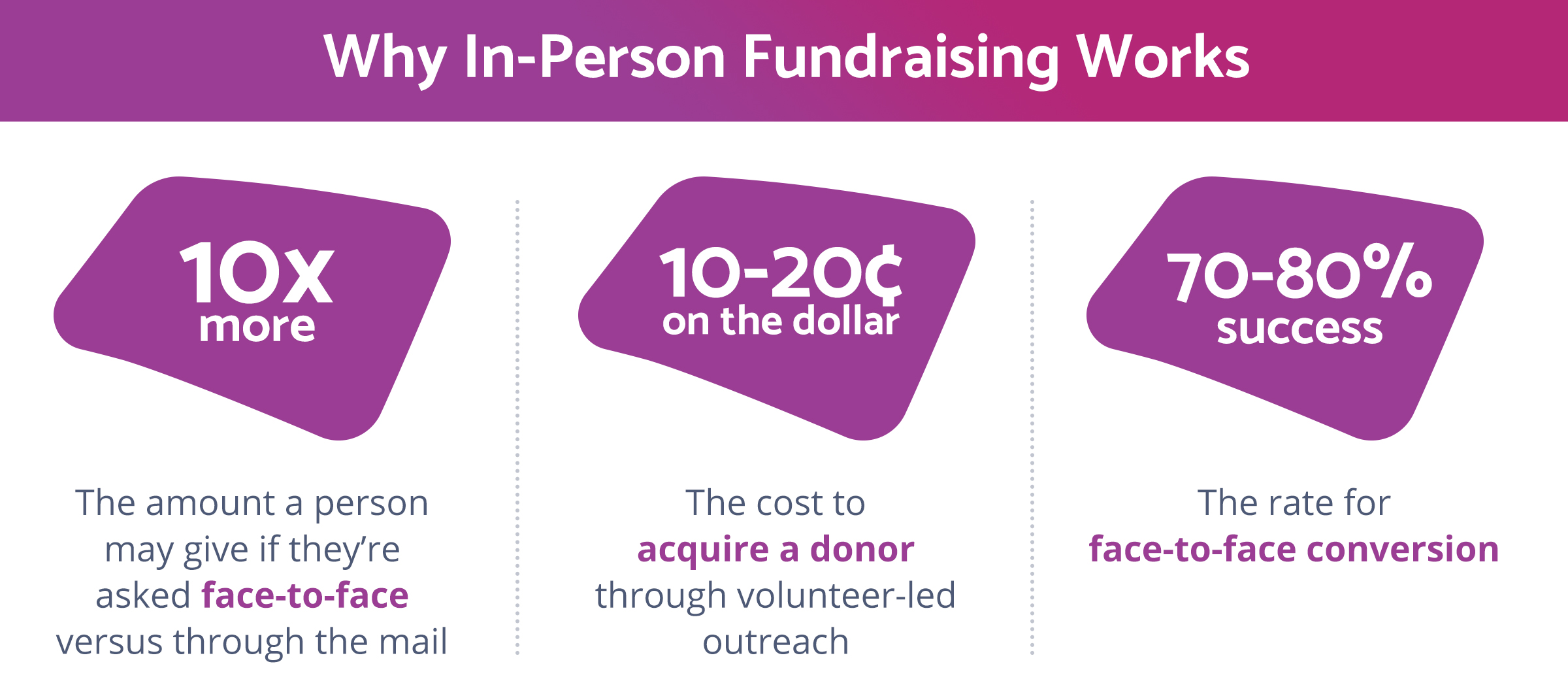
Why In-Person Fundraising Works
- 10x more: The amount a person may give if they’re asked face-to-face versus through the mail
- 10-20 cents on the dollar: The cost to acquire a donor through volunteer-led outreach
- 70-80% success: The rate for face-to-face conversion from conversation to donation
Step 10: Best Practices for In-Person Fundraising

Hopefully the work you’ve put into creating a compelling story for your NPO, getting to know your donors, setting fundraising goals and structures, and creating a marketing strategy has positioned your fundraising team for success. Here are 7 steps to ensure your face-to-face fundraising efforts are successful.
1. Warm up the donor before the ask.
In some cases, the person you’re speaking to is already acquainted with your cause thanks to a proactive marketing and communication plan. Other times their first interaction with your charity will be when you come face-to-face with them. In either case, it’s important to present your NPO story and elevator pitch in a compelling way. Turn attention to the beneficiaries who seem to be most in-line with your supporter’s values before you make your ask. This helps them see and feel the direct impact their contribution can make.
And remember… a smile and a handshake go a long way.

2. Do your research.
In addition to knowing your story inside and out and being highly comfortable with the pitch you’re using, prepare for your audience by considering:
- What types of people are you speaking with today?
- What brings them to your location?
- How much time do they likely have to speak with you?
- Could they already be familiar with your cause?
- Is it likely that they support other charities?
- What are the common objections they may have?
3. Speak less.
The key to recruiting recurring donors (the most valuable type) is to ask just a few key questions and allow the person to respond without interruptions or assumptions. Listen intently and pick up on key indicators of what messaging will convince this person to give, and which donation tier makes the most sense. For example, if they are a parent, how does your cause impact children? Thanks to your compelling NPO story and clear marketing materials, you don’t need to spend your limited time with a prospect overselling your cause.
4. Be conversational.
By listening intently 75% of the time during your interaction, you can ask key follow-up questions. Yes, it’s important to be rehearsed, know your elevator pitch and memorize the key points to hit. But the true secret to success is making this a two-way conversation where you move naturally through your talking points while responding what the person is saying. Engaging with people naturally is a skill worth mastering.
5. Avoid being generic.
Keep your pitch and conversation focused on your specific cause and the direct impact of a donation. Explain clearly how each gift helps, referencing the exact dollar amount and subsequent impact whenever possible. Share the donation tiers you’ve established along with their direct results. Don’t make assumptions about the person based on your interaction, but do try to place yourself in their position and consider what would most appeal to you.
6. Focus on solutions.
It’s easy when talking about your cause to focus on the needs you’re meeting. We highly recommend focusing on the outcomes instead. Rather than talking about the lack of clean water in a village, or the number of animals in cages, share how funding a well in a village will allow young children to go to school or how many animals you’ll help find forever homes.
7. Practice your ask.
Often making the ask is the most anxious part of the conversation. The donor knows it’s coming. You know it’s coming. Practice makes perfect. Write down your ask and practice it. Consider the ways you may need to adjust the ask based on the donation tier or personal experiences that has shared. Be empathetic and encouraging, explaining again very briefly how their gift will make an impact and close with a strong call-to-action.
Step 11: Building Your Fundraising Dream Team

Now that you’ve mapped out a comprehensive fundraising strategy for your charity, the next steps are to identify the people and tools you need to execute your strategy. Your fundraising team actually includes more members than just those with their boots on the ground. Rather, employees throughout the organization can engage with donors. Everyone from entry level employees, to your company leaders should be involved in executing your fundraising strategy and improving donor retention rates. Consider the following roles and departments that all contribute to a successful fundraising program for your charity:
- Strategy: Your organizations strategic team members will oversee many of the iniatives that fuel your fundraising strategy. They’ll likely use research to drive and optimize fundraising campaigns.
- Public relations: An in-house or outsourced PR team will help you develop and execute strategies to reach new supporters through traditional and digital media routes. They may even be involved in creating gorilla marketing campaigns to help your organization create buzz.
- Events & experiences: Events team are focused on planning staff galas, pop-up events, in-store interactions and more. Event and experience employees are incredibly valuable to your donor retention efforts as they often interact with donors face-to-face. Additionally, events are where your campaigns come to life in the real world. A well-executed event can be the difference between reaching your campaign goal.
- Executive Team: Senior leadership will be in charge of driving your comprehensive fundraising strategies.
- Marketing: Marketing teams will build awareness, drive online and in-person donations, support retention, produce strategic content marketing materials, and manage your online presence
- Donor recognition: To increase retention and satisfaction
- Budget development/management: To set fundraising goals, manage budget, track spend and monitor ROI
- Boots on the ground: To spread awareness, raise funds and build relationships with new donors
Define Roles and Responsibilities
Depending on the size of your organization, you may staff these types of roles individually or one person may wear multiple hats, such as digital marketing and public relations. Consider your staffing budget and overall goals; then decide which positions are need-to-haves and which are more future-oriented. No matter which department or role you are hiring for, it’s important that everyone is working toward a common objective: accomplishing the goals laid out in your non-profit’s mission statement.
Finding a Partner to Support Your Fundraising Strategy
Sometimes, it’s beneficial to your fundraising strategy to hire an agency partner who can help you reach your goals. When choosing to outsource all or part of your fundraising strategy, look for a partner who is:
- Data-driven: Digging into donor data is essential to crafting a successful acquisition plan. The right agency partner will understand the power your past data has to unlock future support.
- Tech-savvy: Fundraising looks very different than it did even 15 years ago before digital transformation. Non-profits must learn how to effectively engage new generations who receive and respond to messages very differently. An agency partner who is tech-savvy will help you adapt your fundraising strategy to different audiences and will introduce you to technologies that can streamline your efforts.
- Proven: Effective processes take years of trial and error to perfect. Find an agency marketing partner who has proven results working with established NPOs and understands the unique challenges and successes that organizations like yours face.
Step 12: Identifying the Right Technologies

Technology is often overlooked in fundraising strategies, but it’s actually an essential part of any charitable organization’s approach to donor management and communication. Some tools are designed to streamline the management of the massive amount of data associated with maintaining supporter profiles. Other tools, like email marketing programs, are designed to maximize your communication strategies. Some do both! Here are the most helpful types of technology that NPOs can use to maximize fundraising success.
Non-Profit CRMs
A CRM, or customer relationship management, is a type of software used to manage contacts. Keeping updated and accurate records of your donors is critical to the success of your fundraising efforts, and a CRM helps you do just that. Find a non-profit CRM that was built to specifically interpret donor data and activity and suggests engagement opportunities that result in recurring donations. Reporting, analytics tools, and list segmentation are all key features.
Donor Research Tools
Prospect research software helps NPOs identify major donor prospects within their current supporters, based on wealth markers and philanthropic indicators. It provides additional insight beyond the marketing metrics you will obtain through your other software and technology tools. Some tools like DonorSearch are all inclusive, while others like Double the Donation are just a piece of your overall strategy.
Merchant Account Platforms
Your NPO needs to be able to process online donations as well as donations made with a credit card at in-person events. A merchant account is a bank account that allows NPOs to process payments via credit or debit cards. Similar to the other technologies we have shared, it’s important to find a payment processing partner with experience working with NPOs. These providers charge varying fees so you’ll want to review their terms to find the right fit.
Analytics Tools for NPOs
Analytics and reporting may or may not be included in the CRM system you use. If the CRM was designed for non-profit use, or has been heavily adapted as such, you may have access to the data you need to make informed decisions. If not, it’s useful to find a third-party option to provide analytics and reporting for your NPO. These tools will give you insight into your audiences, their donation behavior, and even which parts of your digital strategy, including social media and your website, are most effective.
Marketing Automation
Marketing automation tools help take your fundraising strategy to the next level. Using these tools requires planning ahead, so be sure you’ve worked through this fundraising strategy to outline your audiences and messaging. Automation tools allow you to create multiple series of messages that are triggered by certain activities (such as a first time donation, a supporter who has lapsed for a certain time period, or someone who requests more information through your website). Many of these automated features may be incorporated in your CRM or email system already.
Crowdfunding Platforms
Crowdfunding was first used by entrepreneurs as a way to raise money with donations from a large number of people. NPOs are becoming increasingly active on NPO-focused crowdfunding sites because they enable NPOs to reach a very broad audience with minimal upfront costs (there are varying fees associated with collecting donations once your giving goal has been reached). The online project listing can easily be shared on social media, which also increases the overall potential reach of your message, with no additional fees required.

Step 13: Harnessing the Human Connection

There’s little doubt that technology has changed the ways that nonprofits interact with the public and their donors. While some technology, like social media for instance, has significantly improved the reach nonprofits have with potential donors, nothing compares to the meaningful connects that are made in face-to-face interactions.
Why the Human Connection is Powerful
Creating strong, emotional connections with donors from day one will drive your mission forward. Because it’s innate for humans to make connections with others, the best fundraising strategies incorporate a mix of digital and face-to-face interactions. They understand the most impactful relationships aren’t built from behind a screen.
Employing a human-first approach to fundraising strategies means applying a donor-first mentality to everything your nonprofit does. Constructing a successful nonprofit fundraising strategy requires many moving parts: research, marketing, events, and way more. But how are you listening and engaging with your donors? How much time is spent nurturing those relationships? Because at the end of the day, your donors drive your mission forward because they are also passionate believers in the cause.

Digital and in-person outreach initiatives should work in tandem to provide the biggest impact on your donor retention rates, and overall fundraising goals. Here are some real life examples of how to best connect digital and face-to-face interactions:
Drive event attendance with social media and email outreach: Use social media and email to drive the attendance of your in-person events. Prior to an event, create engaging materials and share it with your social media and email lists.
Conduct surveys to better understand your donors: The data you collect through online surveys will help you adapt your in-person touchpoints. For example, after a donor event, follow-up with attendees and ask them to complete a quick survey about their experiences. The insights gleaned will enable you to continuously improve your in-person strategies.
Build brand awareness with face-to-face strategies: Face-to-face interactions will deepen relationships with your supporters. A donor acquisition expert, like Ascenta, will work with you to map out the markets that matter the most for your cause and develop in-person outreach strategies in those areas. Everything from booth design to print assets will get you noticed by potential donors.


